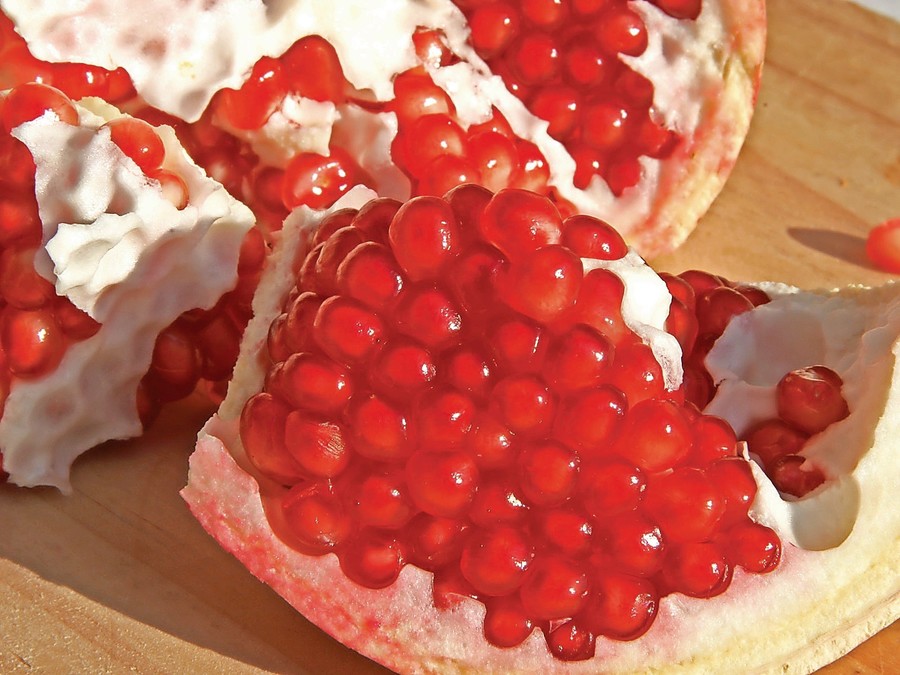Shehechiyanu’s in air
With Rosh Hashana at the doorstep, culinary markers accompany Elul’s piercing shofar blasts and the recitation of Selichot prayers.
Aside from the endearing ritual of the classic simanim — symbolic foods — there is much work to be done. Bakeries have begun selling teiglach, those fried dough pastries soaked and sticky in honey syrup. Apple pickings are underway, the produce to be baked and slumped into cakes, galettes and pies (and, of course, dipped in honey).
For plum jams, the little window for blue Damson Plums, end of August until mid-September, was closing fast. And I’m on the lookout for those hard to come by quinces for another tradition, caramelized quince jam.
Of course, pomegranate, the crowned scarlet red rimon packed with its translucent little ruby gems, is, literally, the crown of all the Rosh Hashana fruits, and is ubiquitous by now.
It’s time for baking those spiralized challot, versus the usual woven and braided Shabbat ones, some hiding studded golden raisins inside. All of them imbued with an extra oomph of sweetness from the honey in the normally lackluster egg glaze.
It’s all about the excess sweetness. After all, it’s Rosh Hashana. The more honey, the merrier, right?
Even root vegetables such as sweet potatoes take on extra layers of sweetness. Remember tzimmes? Now it’s pflaumen (prune) tzimmes. Sweet upon sweet, the sheen of honey shines on them, along with plump apricots, and maybe some flanken to complete this special stew.
But it was not until I was at the Greenmarket the other day when I spied this strange looking thing — sticking out of a horn, it was an eyeball-looking thing staring at me — that I thought to myself, why of course, it’s that time of year again: “Shehechiyanu” fruit!
E
very year, markets in Jewish neighborhoods are flooded with unusual fruits, accommodating the second night of Rosh Hashana custom of blessing a new and rare fruit in honor of the new year.
From prickly pears to star fruit, lychees to pomelos, passion fruit and persimmons, the new fruit is a surprise every year.
And when it comes to persimmon pulp, I don’t remember where I picked this up, but there is the goofy game of examining the shape of the seeds, spoon, fork or knife, as a foretelling of the kind of winter that is in store.
Growing up in Israel, I remember when mangoes, pineapple and kiwi were considered rare and precious. Let alone the likes of passion fruit.
Nowadays, with produce accessible from all over the world, it’s not quite as special and you need to go out of your way to get something really unusual. Or you intentionally eat seasonally, in order to experience the joy of a first bite, a first taste, a first sip, of a season.
I can still remember one year as a little girl when, to our great joy, my father arrived home on erev Rosh Hashana with a whole mini pineapple, considered a delicacy. It was the first time I saw an actual non-canned pineapple — ananas, as it’s called in Hebrew.
So with the abundance and year-round availability of such a variety of fruits, you need to make an effort to find something really different, really exotic, sometimes even quirky. It’s such a joyous little adventure, to hunt down a new and special fruit as a symbol of new beginnings and blessings.
What will that new fruit be? It’s a surprise each and every year.
In its own way, this Shehechiyanu fruit becomes symbolic too. Symbolic of new beginnings and symbolic of the surprises and possibilities that the New Year can bring.

 48.0°,
Overcast
48.0°,
Overcast 




